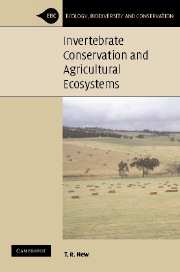Book contents
- Frontmatter
- Contents
- Preface
- Acknowledgements
- 1 Introduction: agricultural ecosystems and conservation
- 2 Agriculture and biodiversity: the place of invertebrates
- 3 Agriculture: effects on invertebrate diversity and conservation
- 4 Agricultural disturbance: diversity and effects on invertebrates
- 5 Biological control and invertebrate conservation
- 6 Cultural aspects of pest management
- 7 Extending beyond cropping areas
- 8 Field margins and landscape ecology
- 9 Pasture management and conservation
- 10 Towards more holistic management for invertebrates
- References
- Index
10 - Towards more holistic management for invertebrates
Published online by Cambridge University Press: 29 July 2009
- Frontmatter
- Contents
- Preface
- Acknowledgements
- 1 Introduction: agricultural ecosystems and conservation
- 2 Agriculture and biodiversity: the place of invertebrates
- 3 Agriculture: effects on invertebrate diversity and conservation
- 4 Agricultural disturbance: diversity and effects on invertebrates
- 5 Biological control and invertebrate conservation
- 6 Cultural aspects of pest management
- 7 Extending beyond cropping areas
- 8 Field margins and landscape ecology
- 9 Pasture management and conservation
- 10 Towards more holistic management for invertebrates
- References
- Index
Summary
Approaches to harmonising and integrating the primary aims of agricultural producers and invertebrate conservation advocates involve exploring more effectively the common ground that already exists between these disparate priorities. Increasingly, both agricultural production and conservation are considered at the landscape level, and some aspects of more holistic area-wide management are discussed in this chapter, together with the complementary roles of practices such as agroforestry. Approaches towards more holistic management for invertebrates, and progressive refinement of pest management to facilitate this, necessitate wider recognition and development of the mutual interests that are largely already evident.
Introduction
The foregoing chapters have demonstrated that agriculture is one of the primary vectors of habitat modification, and that much of such modification for agriculture has been at the expense of more natural environments, including native vegetation, and of the biota they support. Within the wider landscape, studies on invertebrates have been of considerable importance in clarifying the effects of agricultural practices (Collins & Qualset, 1999), with recent emphasis on developing cultural control measures for pests and appreciation of features such as field margins conveying the practical lessons of conservation need (albeit focused primarily on taxa seen as beneficial in pest management) and establishing it firmly on the practical agendas of agricultural producers. Thus, the appreciation of values of generalist, often native predatory arthropods has led to calls for an increased ‘predator buffer’ in cropping systems (Hokkanen, 1997), in essence the maintenance of a diverse and relatively stable predator guild that can respond – or be manipulated – and aggregate to pest ‘hot spots’.
- Type
- Chapter
- Information
- Invertebrate Conservation and Agricultural Ecosystems , pp. 277 - 311Publisher: Cambridge University PressPrint publication year: 2005

